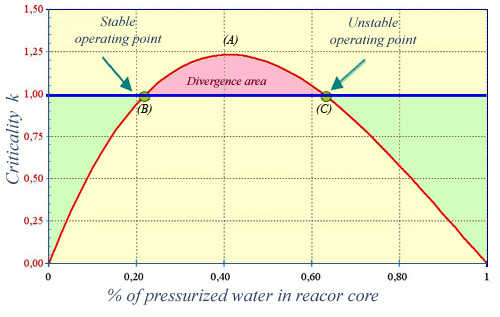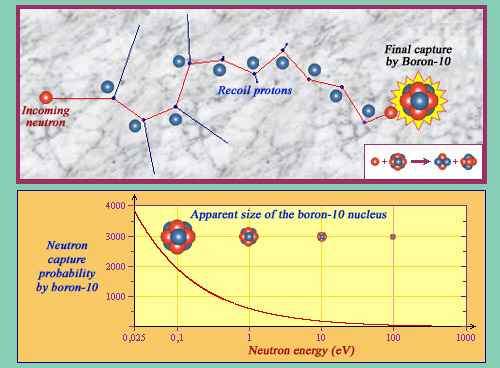Maintain and control the chain reaction
Piloting a nuclear reactor is a complicated task which revolves around a seemingly simple precept : keep the chain reaction running smoothly during weeks and months, without interruption whilst never tending towards the beginning of a nuclear explosion. This balance can be kept if the process delivers, per fission in average, slightly over one neutron available for a secondary fission. This is the case in reactors, which leaves a little room for the manoeuvring The reactor is therefore operated to maintain its ‘criticality’ (the number of secondary neutrons triggering effectively a new fission) at a value of 1. Should any temporary destabilisation take place, the reactor is designed to behave in such a way as to return to the desirable criticality.
Reactor designers chose a well-defined equilibrium point to achieve a natural regulation of criticality, so that small variations in power naturally would correct themselves accordingly to the laws of physics. With a well chosen operating point, a variety of phenomena result in a self regulation mechanism; the most important being the “Doppler effect”. An increase in temperature increases the thermal agitation of the nuclei present in the reactor core. It turns out that the more this thermal agitation is, the more the losses by capture of neutrons during the slowdown are. As a result, the chain reaction slows down and the temperature gradually drops.

Criticality and a stable operating point
In a pressurized water reactor, water is used both as a moderator and a coolant. The criticality (or criticity) peaks above 1 for the repartition (A) between fuel and water. Conversely, the reactor does not function without fuel or moderating water (points 1 and 0 on the % axis). Between these extremes, there are two distributions B and C for which the criticality is equal to 1. The distribution (B) is chosen by engineers because it provides stable operation: If the reactor enters into the zone of divergence of the chain reaction, the temperature increases and the amount of water (moderator) decreases. More neutrons are lost, which naturally brings the criticality back to 1.
© IN2P3
In the case of a limited divergence of the chain reaction, the control of the chain reaction is facilitated by a phenomenon which may seem like a side-effect. A small fraction of the secondary neutrons are emitted with a delay of several minutes. If the criticality is slightly above 1, the delayed arrival of these neutrons gives time to react to prevent an explosive divergence and to introduce control rods absorbing neutrons. The delayed neutrons play an important role in the steering and control of a reactor. They are three times more abundant in uranium 235 (0.65%) than they are in plutonium (0.21%). This is an inconveniency for reactors using nuclear fuels including plutonium.
Some nuclei have a strong affinity for slow neutrons and can absorb them very easily. This is especially true for cadmium, which has a higher probability of capturing a neutron than uranium-235 to undergo a fission. The introduction of cadmium control rods in the core of nuclear reactors stops the chain reaction This is why cadmium control rods are introduced or removed to slow down or accelerate the chain reaction. This introduction or removal, that are mechanical and relatively slow, are used to control the reactor power or to shut it down completely.

Adding boron to primary water
Boron 10 is an efficient absorber of slow neutrons, used in PWR reactors. A small amount of boric water is mixed with the primary water that serves as a coolant and moderator in the core. The hydrogen protons of the primary water slow the neutrons down by a series of collisions until they are absorbed by boron nuclei. The absorption probability for neutrons in boron 10 increases as the neutrons are slowed down. The capture of a neutron by a boron nucleus results in the formation of an alpha particle and a nucleus of lithium 7, This neutron absorption by boron reduces the number of neutrons available for the chain reaction. (For the sake of visibility the paths of the recoil protons have been enlarged in the picture).
© IN2P3
Boron 10 is another efficient absorber of slow neutrons. It is used in pressurized water reactors to temper the speed of the fission reaction, when the reactor has been reloaded with fresh fuel. A small quantity of boric water is mixed with the primary water that play the role of moderator and coolant. The boron nuclei restrain the number of fission reactions taking place in the fresh fuel by absorbing neutrons. They are progressively destroyed by these neutron captures in parallel with the amount of fissile uranium-235 in the fuel, so when it is no more necessary to bridle the reactor boron has vanishes simultaneously.